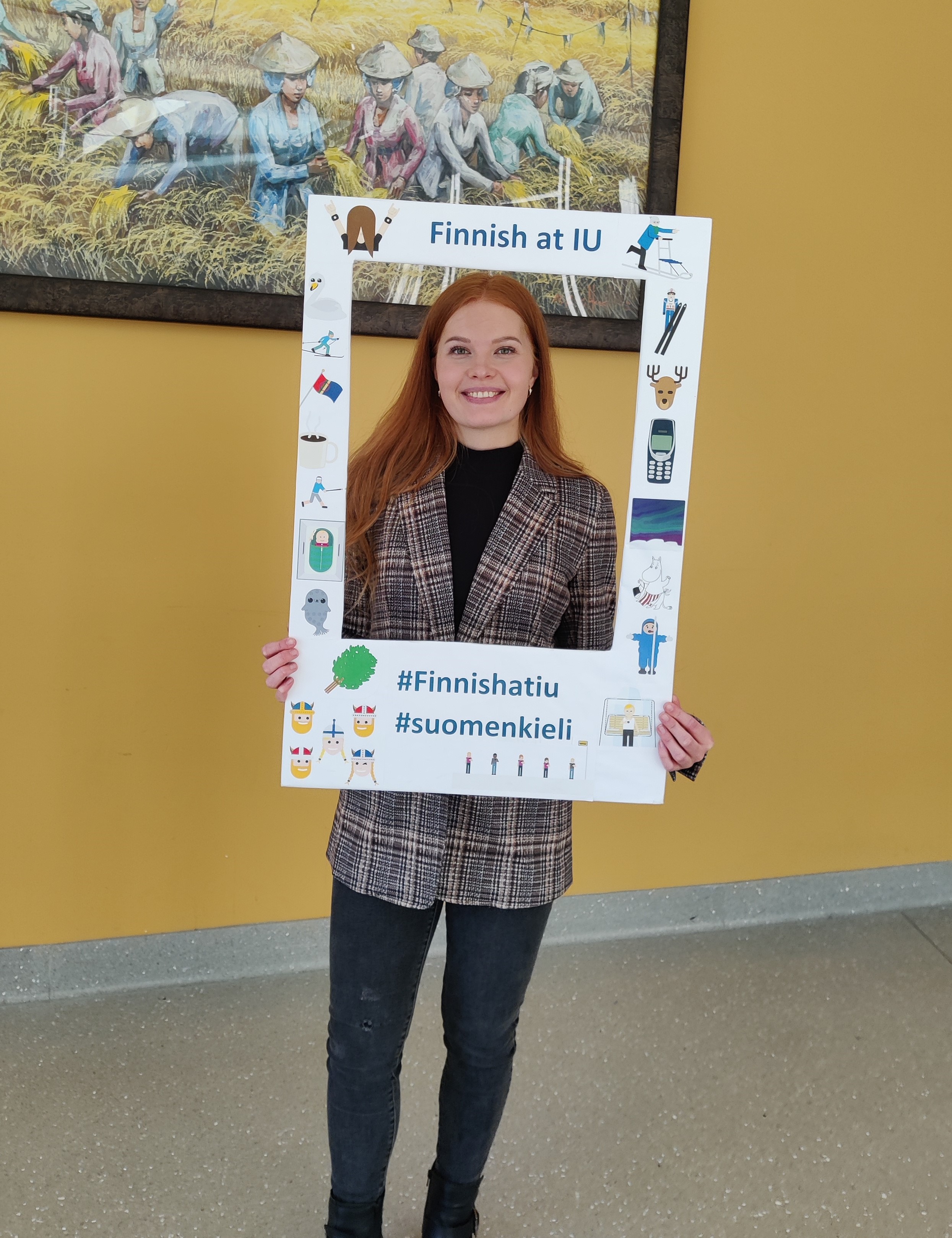Can you introduce yourself briefly and tell us a little about your background?
I am Laura Niemeläinen, and I am the Finnish Foreign Language Teaching Assistant in the CEUS Department. I will be graduating this spring from my master’s program as a Finnish language and literature teacher, with a specialization in second language teaching. Alongside my studies I’ve worked as a global educator for several years, and as a substitute teacher during the past two years. I have always been intrigued by different cultures and languages as well as pedagogy, and enrolling in the Fulbright FLTA program has given me a great opportunity to learn more.
How many sections of Finnish are you teaching and how many students do you have? Why should students learn Finnish?
I currently assist three classes per week and teach two classes independently. There are three Finnish courses taught this semester, and we have 10 students altogether. I think studying any language that is much different than your own – especially in the case of Finnish – offers a great deal of possibilities to get to know yourself better, understand different ways of interpreting the world, and meet people you never thought you might get to know.
The Finnish language is creative and word play is central in the language, so learning it can be a lot of fun. Since Finnish is only spoken by around 5.5 million people and is probably very different from any other language you have ever studied, you would be connected to a cozy community of other persistent Finnish learners.
What classes are you taking here at IU, which one do you like the most, and why? What is different about taking classes in the US?
I’m taking a course on creative and critical writing in French and a course designed for FLTAs called Teaching Less Commonly Taught Languages. Both classes have given me a lot of experience and have their pros. The latter class deepens my knowledge of foreign language teaching, and we always have analytical and inspiring conversations. In my French class, however, we have truly experienced language learning beyond the classroom. We’ve been to parks, museums, and operas, toured the Musical Arts Center’s backstage, wardrobe, and staging, as well as interviewed a French-English translator while enjoying some French treats – among other fun things that I did not expect when I first registered for the class.
There are some differences that I have experienced between taking classes in the US and in Finland, one of them being the significance of course grades. Good grades really matter in terms of being able to proceed to a more advanced class. It’s also interesting to have the ability to audit classes, which is not a common practice in Finland.
Is this your first time visiting the United States? If so, what are your thoughts?
This is my first time visiting the US, and I really love it in Bloomington. What I have heard and seen so far, is that the country is extremely diverse and each state has its own laws and regulations. Also, even if I had already had an idea about the American take-away culture, I have been surprised by how often people take out food, and I love seeing people have a walk with their favorite take-away drink in hand.
Is there anything you miss from Finland that you have not been able to find here?
Besides my family I definitely miss Karelian pies (karjalanpiirakka) and sauna! Also, going to a lähikauppa, a grocery store just behind the corner, is something that they don’t have here in the US. It is so convenient to just walk to a small grocery store very close to you and find everything you might need at that moment.
What is your favorite thing to do at IU so far (when you're not teaching or taking class)?
My favorite thing to do at IU so far has been enjoying the arts that IU has to offer: concerts, opera, ballet, and of course walking through the beautiful IU campus.
Is there anything you’d like the readers to know about Finland?
There are over 3 million saunas in Finland, and we really love to sauna. We have saunas for nearly every occasion: Christmas sauna, Midsummer night’s sauna, bridal sauna, and talkoosauna, just to name a few.
Do you think learning Finnish is difficult for an English speaker?
Yes and no. I would say the easy part is that Finnish is pronounced as it is written. However, learning the 15 noun cases in Finnish that often correspond to expressions containing prepositions in English sometimes puzzles a lot of native English speakers. There is also a great number of idiomatic expressions commonly used in the Finnish language that are best learned in context.
Do you have any advice for learning languages from your own experience?
Curiosity and fondness for experimenting are great bases for language learning. Language is also best learned when practiced in real-life contexts. Visiting a place or community where the target language is spoken has significantly enhanced my language learning. It is both motivating and intriguing to learn how people actually use the language. That is why I often like to discuss the use of spoken Finnish in different contexts with my students.
What is a fun or interesting phrase in Finnish that more people should know?
Kokoo koko kokko kokoon. Koko kokkoko kokoon? Koko kokko kokoon.
Put together the whole bonfire. The whole bonfire together? (Yes,) the whole bonfire together.
This tiny dialogue not only shows the peculiarities of Finnish language, but also reveals the magic of the Finnish Midsummer celebration when Finns enjoy gathering to watch a burning stack of dry twigs.


